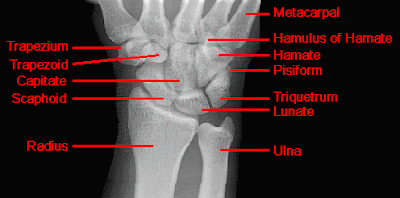Etiology
The 2 major causes of Lisfranc injuries are low-energy, sports-related injuries and high-energy motor vehicle and industrial accidents. In low-energy settings, TMT injuries are caused by a direct blow to the joint or by axial loading along the MT, either with medially or laterally directed rotational forces. In high-energy injuries, the method of loading is not significantly different, but the energy absorbed by the articulations results in significantly more collateral damage to bony and soft-tissue structures, creating such injuries as MT fractures, cuneiform instabilities, and cuboid fractures.The damage to the tight, ligamentous structures of this joint complex creates an unstable foot for weight bearing. The sense of instability and pain can occur whether or not overt evidence of instability is present. Chronic sprains resulting from relatively minor trauma can be the most debilitating sprains due to pain with weight bearing.
Pathophysiology
In diabetic patients with neuropathy or those with idiopathic insensate feet, subacute diastasis can occur over time without notable pain. Due to the absence of pain, this gradual process occurs, so that a minor injury can lead to a Lisfranc injury. In the authors’ opinion, the hallmark of an impending Lisfranc injury is the loss of the recess of the second MT base with the cuneiform, also known as the keystone. Radiographs are considered abnormal when weight-bearing anteroposterior (AP) views of the foot show the first TMT joint to be at the same level as the second TMT joint, indicating proximal migration of the first rayPresentation
Patients with Lisfranc injuries can present with obvious anatomic deformities or with variable amounts of pain with weight bearing. Lisfranc injury should be excluded in any patient with midfoot pain on either the dorsal or the plantar aspect of the foot during weight bearing.Clinical signs of Lisfranc injury are the following:
- Swelling out of proportion with a normal radiograph
- Plantar midfoot ecchymosis
- Pain along the TMT joints with palpation, motion, and/or weight bearing
- Midfoot instability
Athletes
Lisfranc injuries are seen more commonly in football players, gymnasts, ballet dancers, and track-and-field athletes. Lisfranc injury in a professional hockey player has also been reported.8 The Lisfranc injury can potentially be a career-ending injury, particularly in elite gymnasts, as noted by Chilvers and colleagues.9 The mechanism of injury for most athletes is axial loading on a hyperplantarflexed midfoot. For ballet dancers, the pointe shoe design has been shown to stabilize the Lisfranc joint while in the en pointe position.
Lisfranc injuries in athletes have been classified according to the American Medical Association’s Standard Nomenclature of Athletic Injuries. First- and second-degree sprains have been classified as partial ligament tears with swelling, focal pain, no instability, and normal radiographs. Instability and diastasis between the first and second MT of greater than 2 mm as seen on AP radiographs is consistent with a third-degree sprain.
Indications
Patients with undisplaced injuries are treated conservatively. Patients with displaced Lisfranc injuries should undergo closed or open reduction. All Lisfranc injuries that cannot be reduced and be made to remain stable by closed means should undergo internal fixation. An absolute indication for open reduction is vascular compromise that does not improve with closed reduction.Relevant Anatomy
The Lisfranc joint is composed of 5 TMT joints in which the first through third MTs articulate with their corresponding medial, middle, and lateral cuneiforms. The fourth and fifth MTs articulate with the cuboid. The Lisfranc joint can be functionally divided longitudinally into the first ray, or medial column; the middle column, consisting of the second and third TMT joints; and the lateral column, consisting of the fourth and fifth TMT joints. A transverse line through these joints is not straight but highlights a recess, termed the keystone (similar to a Roman arch), formed by the second TMT joint. This joint lies approximately 1 cm proximal to the first TMT joint line and 0.5 cm proximal to the third TMT joint line.The joints are bound by thick plantar ligaments that form an interlocking pattern between the tarsal and lesser MT bones 2-5. These are reinforced by attachments of the posterior tibialis tendon. The first TMT joint also has strong plantar ligaments across the joint; these are reinforced by the attachment of the peroneus longus and anterior tibialis tendons. Also present between the lesser MTs is a series of intermetatarsal ligaments, which force the group to function more as a unit. No intermetatarsal ligaments exist between the first and second MTs, which is why they often exhibit divergent behavior. The weaker dorsal ligaments explain the majority of dorsal dislocations.11
The Lisfranc ligament originates from the plantar lateral aspect of the medial cuneiform and attaches to the plantar medial aspect of the second MT base. It is the thickest of the ligaments in this region, measuring up to 1 cm wide. This ligament provides the only soft-tissue link between the medial ray and the lesser MT and is responsible for this area's stability.
Motion at the TMT joints is variable. The second and third joints are the stiffest, with minimal motion in the dorsal/plantar plane and none in the medial or lateral plane. The third and first TMTs exhibit progressively more motion in both planes but still are relatively stiff and mainly function as areas of adjustment to allow the MT heads to share weight equally. The lateral 2 TMT joints demonstrate roughly 3 times more motion in the dorsal or plantar plane than does the first TMT joint. That motion is significant in the function of the foot and must be preserved to maintain normal function, especially if stiffness occurs in the medial and middle columns.
In the column theory, the middle column is more important for rigidity, and the medial and lateral columns are more important for shock absorption during gait. The lateral joints are more important for their mobile contributions to the balancing of forefoot weight bearing. This principle is important in treating these injuries.






















.jpg)